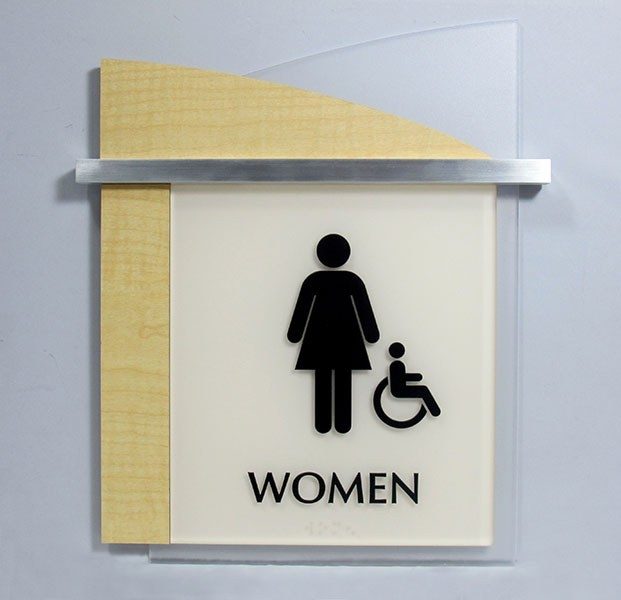A Comprehensive Guide to Picking the Right ADA Signs
A Comprehensive Guide to Picking the Right ADA Signs
Blog Article
ADA Signage: Making Certain Availability and Conformity in Public Spaces
ADA signs plays an important role in assuring access and conformity within public areas, dramatically adding to an inclusive atmosphere for individuals with impairments. As we discover the nuances of ADA signs, from responsive attributes to develop ins and outs, it's crucial to take into consideration just how these elements coalesce to copyright the rights of all customers.
Relevance of ADA Signage
In modern culture, the importance of ADA signage prolongs past simple conformity with lawful requireds to personify a dedication to inclusivity and accessibility for all people. These signs are vital in producing atmospheres where people with specials needs can browse public spaces with the very same simplicity and independence as those without disabilities. By offering clear and standardized details, ADA signs makes certain that every person can access facilities, services, and information without obstacles.
The relevance of ADA signage depends on its capacity to improve the lifestyle for people with handicaps by advertising equivalent accessibility. It gets rid of the challenges that may otherwise prevent their ability to take part completely in neighborhood life. These indicators serve as visible indicators of an organization's dedication to variety and equality, mirroring wider social worths that promote the rights and dignity of all people.
Furthermore, ADA signs plays a critical function in public safety. By directing individuals to exits, toilets, and other important centers, it makes sure that all individuals, regardless of physical capability, can leave securely throughout emergencies. In recap, ADA signage is not simply a regulatory need but an effective tool for fostering a equitable and comprehensive society.
Secret Elements of Conformity

Positioning is crucial; indicators need to be installed in areas that are reachable and conveniently visible. Normally, signs must be installed between 48 and 60 inches from the ground to ensure ease of access for both standing and wheelchair individuals. Responsive components, such as Braille, are crucial for people with aesthetic problems, providing essential information in a non-visual style.
High-contrast colors in between the message and background are essential to improve readability for individuals with reduced vision. The ADA mandates details contrast proportions to ensure quality. Additionally, personality dimension is a crucial consideration, with minimal elevation needs dictated by the viewing distance to guarantee readability from different angles.
Style Considerations for Accessibility
Designing accessible signage requires a meticulous technique to guarantee it meets the demands of all customers, specifically those with disabilities. The dimension of the message is equally crucial, with ADA guidelines advising a minimal elevation based on viewing range to make sure readability.
Contrasting colors between text and background are crucial for presence, especially for individuals with visual disabilities. A high contrast ratio assists identify the text from its background, boosting readability under different lighting problems. Additionally, tactile elements, such as Braille and elevated personalities, are vital for people that are blind or have low vision. These aspects should be found at a constant elevation and position to make certain easy accessibility and understanding.
In addition, the placement of signs plays a substantial function in accessibility. Signs need to be set up in areas that are easily obtainable and unhampered. Making certain that signage is mounted at suitable elevations and angles allows all users, including those using wheelchairs, to connect with them effectively.
Typical Blunders to Avoid

Another widespread error is the wrong positioning of signs. ADA guidelines define precise height and location needs to make certain that signs are reachable and conveniently noticeable by all people, including those making use of wheelchairs. Neglecting these guidelines not only hinders availability yet likewise takes the chance of non-compliance with lawful requirements.
In addition, inadequate comparison in between message and history is a constant oversight. Ample comparison is important for readability, especially for individuals with reduced vision. Designers sometimes pick colors that are aesthetically attractive but do not have the essential comparison, providing the message difficult to discern.
Last but not least, some designers fall short to include responsive components, such as Braille, which are critical for individuals who are blind. Omitting these features not just causes non-compliance with ADA guidelines helpful hints but likewise restricts access for a segment of the population that depends on tactile info.
Future Trends in Signs
Developments in modern technology and enhancing understanding of inclusivity are forming the future patterns in signs design. As culture becomes much more mindful of varied requirements, the assimilation of clever technologies into signs is gaining grip. Digital signage, as an example, is developing to consist of interactive features and real-time updates, which can be important in giving dynamic details in public areas. These indications often incorporate touch screens or gesture-based controls, making it possible for customers to browse material tailored to their specific requirements.
One more emerging trend is the use of increased truth (AR) to enhance customer experience. AR-enabled signs can overlay electronic details onto the physical environment, offering visually impaired people with auditory or haptic feedback. ADA Signs. This modern technology not only boosts accessibility yet likewise develops an appealing experience for all users
Sustainability is also a significant aspect affecting signs fads. Green products and energy-efficient lighting remedies are being focused on to line up with global ecological goals. Furthermore, improvements in products science are bring about the advancement of even more weather-resistant and resilient signs.
Conclusion
ADA signage plays a crucial duty in guaranteeing access and conformity within public rooms by incorporating responsive aspects, high-contrast colors, and strategic placement. The adherence to ADA criteria not only facilitates risk-free navigation for people with impairments yet likewise indicates an organization's devotion to diversity and inclusivity. By preventing common errors and embracing future fads, public spaces can proceed to advance these worths, making certain that the rights and dignity of all people are valued and supported.
ADA signs plays an indispensable duty in assuring ease of access and conformity read more within public areas, substantially contributing to a comprehensive setting for people with specials needs. As we discover the nuances of ADA signage, from responsive attributes to design ins and outs, it's critical to think about how these aspects integrate to copyright the legal rights of all individuals.In contemporary culture, the importance of ADA signage extends past mere compliance with lawful mandates to embody a commitment to inclusivity and access for all people. By giving standardized and clear info, ADA signage guarantees that everyone can access centers, services, and info without go to my site barriers.
ADA signs plays an important duty in assuring availability and conformity within public areas by including responsive components, high-contrast shades, and calculated placement. (ADA Signs)
Report this page